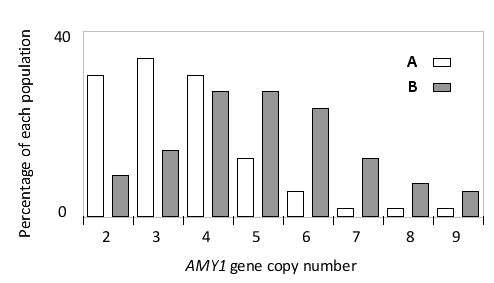Short Answer
The copy number of some human genes, such as the salivary amylase gene AMY1, varies greatly between different individuals. The salivary amylase breaks down some of the dietary starch into smaller sugars. In the case of AMY1, a positive correlation has been observed between the copy number and the amount of amylase in the saliva. Gene copy number per diploid genome can be estimated by performing a quantitative polymerase chain reaction (PCR) using primers specific to the gene of interest. You have performed such PCR experiments on samples from two human populations that have traditional diets with low and high starch levels, respectively, and have plotted the data in the histogram below. Which population (A or B) in the histogram is likely to be the one with traditionally higher dietary starch? Write down A or B as your answer. 
Correct Answer:

Verified
Since the correlation of gene copy numb...View Answer
Unlock this answer now
Get Access to more Verified Answers free of charge
Correct Answer:
Verified
View Answer
Unlock this answer now
Get Access to more Verified Answers free of charge
Q41: The centromeric regions in the fission yeast
Q42: The eukaryotic chromosomes are organized inside the
Q43: Indicate whether each of the following histone
Q44: In assembling a nucleosome, normally the …(1)
Q45: Indicate true (T) and false (F) statements
Q47: Fill in the blanks in the following
Q48: Fill in the blank in the following
Q49: Imagine a human protein containing 33 repeats
Q50: Compared to the human genome, the genome
Q51: To discover genes that have undergone accelerated